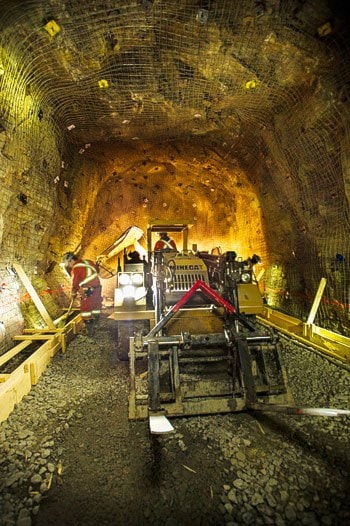When the Minto copper and gold mine near Pelly Crossing opened in 2007, it was expected to produce up to 1,600 tonnes of ore per day for about four or five years.
Today, Capstone Mining Corp. expects the operation to generate an average of 3,850 tonnes of ore per day through 2022. And that only accounts for the resources it has already explored.
“There’s lots of potential at Minto,” said Ron Light, the mine’s general manager. “We didn’t do any exploration drilling in 2013 but we have a budget for 2014 and Minto has been very, very successful in their exploration efforts.”
To date, the site has only produced ore through open-pit mining. Later this year, however, underground operations will begin.
The reason for the move to underground mining is to access high-grade mineral reserves deep below the surface.
Between the resources close to the surface and the ones below there are layers of low-grade reserves. By tunnelling, the company can access the good stuff directly without having to dig through the mediocre stuff first.
The main tunnel is already about 350 metres long, and will reach about a kilometre before operations begin.
The company will also need to dig a vertical tunnel into the mine, designed both to allow fresh air in and provide a second escape route in case of an emergency underground.
The hole will be about 70 metres deep and will be fitted with ladders.
That should be completed by July or August, said Light.
Underground production is expected to begin shortly after that, and it will gradually replace ore mined from the open pit.
Sometime in 2014, underground production will equal open-pit production, said Light.
The mine’s open-pit operations are currently managed by contract with Pelly Construction Ltd. But that company is not equipped to run the underground work, so Capstone has contracted the development of the mine to Dumas Holdings Inc.
Once the underground mine moves from development to production, Capstone will staff and manage the operations.
That means that it needs to hire more people. The underground mine will generate at least 40 jobs, said Light.
The company has already begun staffing their management team, and will begin active recruitment for mining positions this month.
“Our main goal is to try and get people from the Yukon, or to get people who are willing to relocate to the Yukon,” said Light. “And our other primary goal is to train some of the Selkirk First Nations, or other First Nations, in the underground operations.”
The company is opening a Whitehorse office to help with recruiting.
Additionally, Capstone has partnered with Yukon College, Alexco Resource Corp., Yukon Zinc Corp. and the Yukon government on a training program designed to get more Yukoners employed in mines.
The Introduction to Mining Operations program is a 44-day course that offers students an orientation to both surface and underground mining, essential safety certifications and the opportunity to complete a two-week shift at one of Yukon’s producing mines.
Four students have just finished their placement at the Minto mine.
“They were telling our miners, contractors and our tradespeople how much they enjoyed the site, that they don’t think they’d mind working away from home, that they felt there was a good wage to be made, and that Minto was a very safe site,” said Light. “And one of the things we promote there is safety, so if the students notice it, it says a lot.”
And there will be jobs for the graduates, he said.
“We’ve already had emails asking if we can hire one of them, and I said, ‘Not until they complete the program,’ which I think is next week.”
Capstone is planning to hire labourers, underground truck drivers, loader operators and drillers for their underground work.
Some open-pit workers can convert to underground, but often specialized skills are required, said Light.
For example, the drill used in pits is different from the drill used underground. The underground drill is controlled electronically and requires a lot more technical expertise.
In addition to skills, it wouldn’t hurt to have a strong will.
“You need the fortitude to work underground,” said Light. “It’s a little unpleasant to some when they first go there.”
The company employs a liaison person to work with the Selkirk First Nation and promote local hiring.
In less than a year that Light has worked at the mine, the percentage of employees from the Selkirk First Nation has gone from about nine to about 15, he said.
“I’ve worked with other indigenous people throughout Nunavut and the Northwest Territories and I would say that this is probably the best relationship I’ve seen built between a company and a First Nation.”
The overall level of aboriginal employment is over 25 per cent, he said.
Fifty per cent of the workers are Yukoners, and 13 per cent are women.
And the jobs pay well, he said.
“We’re in the upper 75 percentile of northern remote mines as far as pay scale goes. That’s right down to the janitor and the labourers.”
Contact Jacqueline Ronson at
jronson@yukon-news.com
